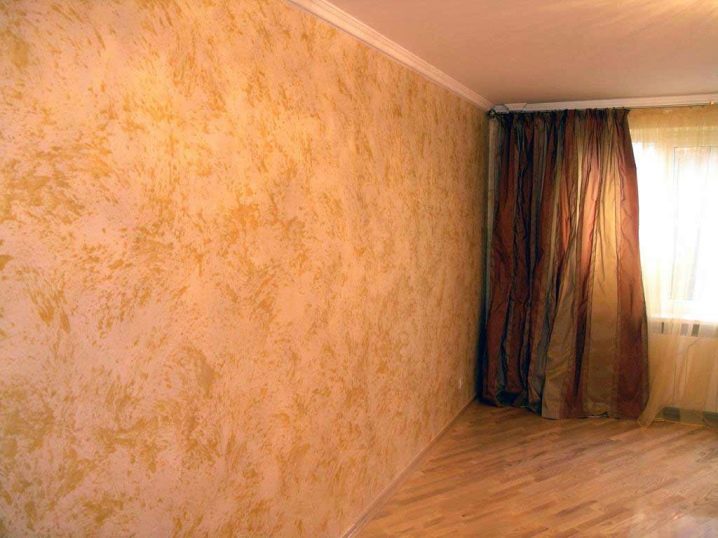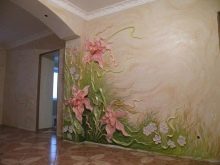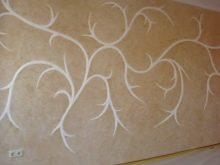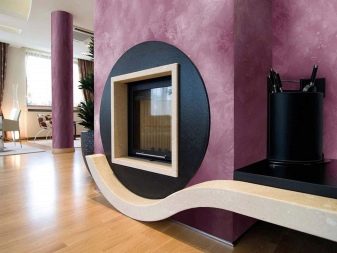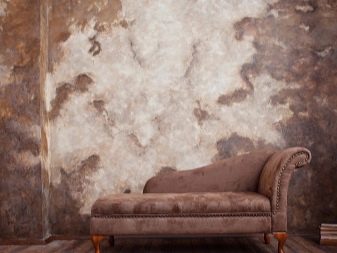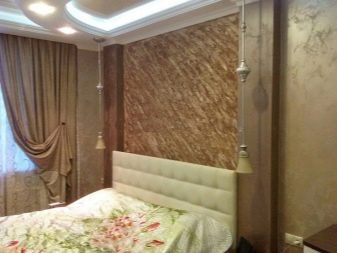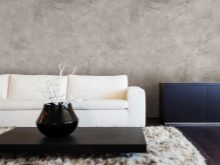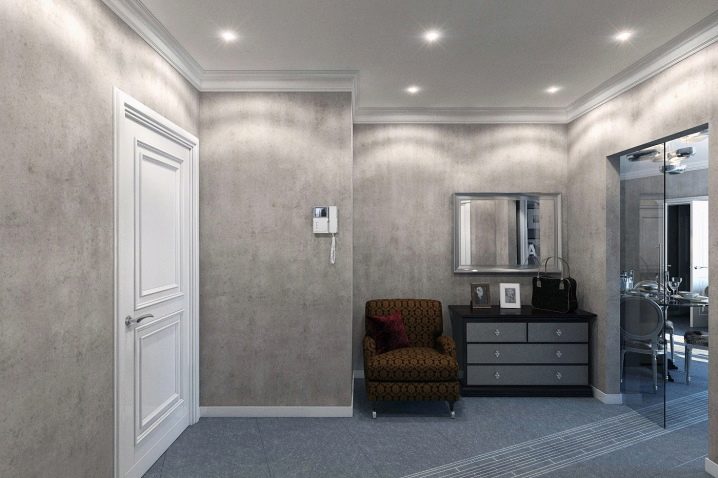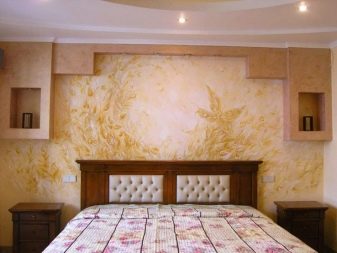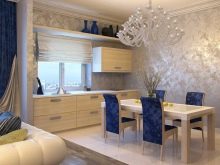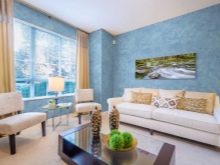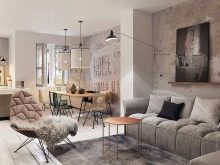Decorative plaster in interior design
Decorative plaster is a very interesting material, with the help of which you can create an interior design that is distinguished by originality and unsurpassed beauty.
After reading this article, you will learn about the benefits of such coverage, as well as what nuances you should pay attention to when choosing the right option.
Special features
At its core, decorative plaster, as usual, is a friable mass. However, it differs from other formulations in that it includes additional inclusions: fine wood fibers, stone chips, and so on. Thanks to these ingredients, decorative plasters can be used as finishing coatings, because they look very beautiful and unusual.
If done correctly, the surface looks absolutely complete.
Additional blotches together binder (regardless of the type of elements). Decorative plasters often have dyes, so they do not have to give the necessary shade.
Benefits
Decorative plasters are very popular among consumers due to the large number of advantages.
The main advantages of such materials:
- The ability to use them both for basic and for finishing. Such a coating can fill cracks, cracks. It is characterized by increased ductility, therefore, successfully eliminates all the defects on the surface. For this reason, there is no need to thoroughly prepare the base before applying the plaster. Most often it is sufficient to simply primer the substrate before plastering.
- No restrictions on coverage. It is great for wooden, brick, stone, concrete surfaces, drywall.
- Inability to absorb odors. Thanks to this advantage, decorative plasters are suitable even for kitchens.
- The ability to provide good sound insulation.
- Variety of patterns. The image on the surface will depend not only on the material itself, but also on how exactly it is applied.
- Resistance to various atmospheric influences. This plus attracts many consumers, despite the fact that decorative plaster is usually used for interior decoration.
- The ability to give the surface "breathe". The indoor climate will be optimal.
- Sustainability components, safety for human health.
- Resistance to mechanical damagelong service life.
Kinds
In stores, decorative interior plaster is sold in finished and dry forms. Dry material must be diluted in water, taking into account the necessary proportions. If you are inattentive, some of the mixture will have to be thrown away. It can not be a long time not to use, otherwise it will harden. It is much easier to work with materials in buckets. It is also worth noting that decorative plasters are divided into several types (depending on the composition).
Acrylic
The composition of such materials include acrylic resin. They are very resistant to various deformations of surfaces, because they are characterized by increased elasticity.
Such coatings should not be used with wadded insulation, because they are not fire resistant.
Mineral
These coatings are based on cement, thanks to which they are water resistant and durable. Usually such a plaster is dry, it has to be diluted with water. In addition, it is not colored, so the necessary tone has to be given additionally.
The main advantages of such materials - versatility and affordable cost. They can be used not only for interior finishing work, but also outside the premises. However, on such coatings cracks appear over time because they do not differ in elasticity.
Silicate
When creating such compounds manufacturers use potash glass, and it is quite dangerous for human health. That is why silicate plasters most often used for the implementation of external decoration.
Such material dries out quite quickly, so there may be problems with correcting errors that occurred during operation.
Silicone
The basis of the composition - silicone resin. Silicone decorative plasters are very popular because they are distinguished by aesthetics and excellent performance characteristics.Such coatings can be used both indoors and outdoors: they are very resistant to various atmospheric influences.
The only drawback of such materials is quite a high price, but it is justified by remarkable quality.
Design
People who choose the appropriate finishing material, strive to ensure that the room was unique. At the present time it is very difficult to find such samples that cannot be seen anywhere else - there are more ordinary, standard coatings on the modern market. For some, the use of decorative plaster becomes a real salvation, because with this material you can make any room unique, both in modern and in classical style. Manufacturers offer a variety of textures.
Using decorative plaster, you can get:
- the basis which is ideally suitable for a list;
- imitations of wooden, leather, stone, fabric, concrete, paper surfaces;
- most different patterns, reliefs;
- effect of the aged surface.
Some prefer white materials, but many choose coatings that are characterized by rich colors.Blue, green, black decorative plasters and other similar options are an ideal choice for a modern interior. With the help of such coatings the room acquires brightness and individuality.
When choosing a coating that should become an accent in a stylish interior, you need to focus on the effect you want to get.
There are several main groups of decorative plasters.
Structural
Such a plaster can be quite coarse, because for such coatings the presence of large additional inclusions is typical. As such ingredients are used ground brick, wood, marble chips, particles of pumice and so on. Unusual structure is created using such elements. The surface is uneven, beautiful, very textured.
"Bark Beetle" - affordable and common type of plasters. This is an imitation of a tree with lines that were allegedly eaten by bark beetles.
Textured
These plasters can imitate a variety of surfaces. Using such coatings on the walls, you can create drawings of stone, brick surface, leather, they imitate even silk and velvet materials.
Distinctive features of such coatings:
- They can be used instead of wallpaper;
- Such materials can hide a variety of surface defects;
- Textured compositions almost always have a certain shade.
Flock
These plasters are also called silk. Their features:
- The ability to protect the room from cold and noise.
- Resistance to fungus, mold. Such materials can be purchased for use in bathrooms.
- The ability to pass air remarkably.
- The presence of silk fibers. Thanks to this coating is very pleasant to the touch.
This coating is not too bulky and voluminous. It looks very decorative and elegant.
Marble
This material is the most durable of all that have been listed previously. Additional blotches can be both small and large - you can choose the right option for any interior. Shades are also different. This coating is very relief, volume.
Venetian
Such coatings are the most expensive, but they always have a very aesthetic appearance. Manufacturers offer Venetian plaster in a variety of colors.
How to choose?
Choosing a suitable decorative plaster for a house or apartment, you need to focus on exactly in which room it will be used. Should take into account certain nuances.
On the kitchen
It should be borne in mind that the kitchen rooms are characterized by various odors, high humidity, temperature changes. For this reason it is worth choosing materials that are resistant to all of the above.
For the kitchen should not choose too bright colors, they will make the interior too "heavy" and annoying. Very light colors may get lost.. It is better to stop the choice on something average, so that there is a certain harmony in the room.
You can use decorative plaster for zoning the room, but you should not use it to design a kitchen apron. For this zone it is better to choose fiberglass, tile.
For living room
The living room is the “face” of the house, so this room needs to be decorated with taste. You can stop the choice on glossy, pearlescent surfaces, "wet silk". For connoisseurs of luxury fit large patterns or drawings, for lovers of minimalism - imitation of concrete.
In the hall
The hallway sets the mood when people enter the house. For the corridor, you can choose unobtrusive relief coating, pearl, pearl surfaces, Venetian marble. For such a room also suitable "bark beetle".
For the bedroom
In such rooms a variety of shades and textures look good. For the bedroom, the surface is perfectly suitable for velvet, silk. Highlight accents can be using the "bark beetle."
If the bedroom windows overlook the north side, it is better to choose pastel shades of warm. Cool colors are suitable for the south side..
Remember the basic rule: the smaller the room, the brighter the tone.
Bathroom
The coating for the bathroom must be resistant to abrasion, the effects of fluid, fungus. Thanks to the use of such decorative plaster, not only a wonderful decoration is obtained, but also an optimum indoor microclimate is created.
Balcony
The material for the balcony should provide good sound insulation, keep warm. You can choose textured plaster, but do not buy Venetian - it does not differ in resistance to various atmospheric influences (which is especially important if the balcony is not glazed).
Tips and tricks
When working with decorative plaster, you can add additional components to it: for example, pearlescent, silver, gold particles. They are poured in to get various interesting effects.
Some mix plaster from different manufacturers, but be aware that this can only be done with utmost care. First you need to check if the materials are compatible.. To do this, take a small number of different compositions and try to mix them. Then evaluate the result.
Some decorative plasters are applied an additional protective coating. Venetian coatings, for example, are protected with special wax. It can be water or acrylic. The first one is natural, inexpensive, but can change the color of the coating; the second is better polished, is absolutely transparent.
The new coating looks great, it is resistant to various influences and durability. However, this does not mean that you will not have to look after him. The surface will need to be cleaned using detergents that have a neutral base.
It is recommended to use sponges and soft rags.Pumice stones, stiff bristles and metal scrapers can damage the surface.
To learn how to make decorative plaster under the brick, you can learn from the following video.
Beautiful examples in the interior
White decorative brick plaster is a very good option for a Scandinavian-style room.
An example of a wonderful combination of overall design with a decorative coating.
Blue color gives the room an atmosphere of freshness, makes the room more bright.
Such interesting coatings can be an excellent substitute for wallpaper.
The effect of the aged surface gives the room a unique chic.
Venetian plaster fascinates, it makes the interior more "expensive".











